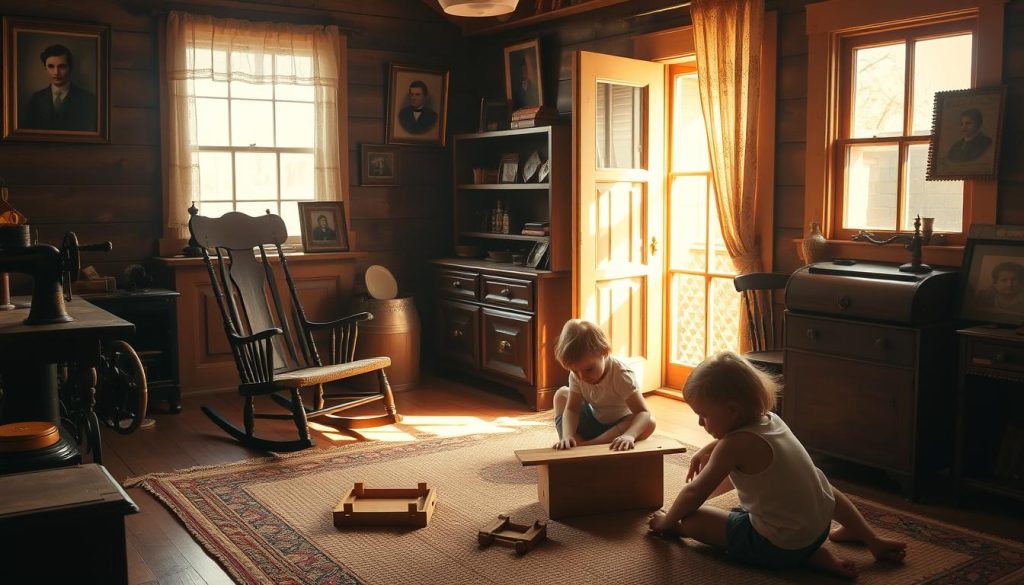It’s eye-opening that half of all Americans say family traditions have changed a lot in just two generations. This highlights how American family culture has shifted. Mixing old customs with new, it creates a unique family traditions in the USA. These customs mix past and present, showing our heritage, beliefs, and social changes. They shape contemporary American households.
American families blend old and new in a complex story. This story is influenced by migration, economic changes, and cultural sharing. Family structures have evolved, moving beyond simple definitions. Recognising these shifts helps us understand the American spirit. It shows resilience, flexibility, and a constant search for identity in a changing world.
An Overview of American Family Dynamics

Family life in America has changed a lot over the years. What we see as a family now includes more than the old-style mum, dad, and kids setup. Today, American families come in all shapes and sizes. This reflects the complexity of society. Diversity in culture, and different family types strongly influence American social life.
The Evolving Structure of American Families
The traditional family is no longer the only norm. The USA now celebrates a variety of family forms. Changes have brought in single parents, same-sex couples, and homes where multiple generations live together. This shows inclusion and diversity at play.
- More single parents exist now, thanks to shifts in culture and law. They get more support and recognition.
- Same-sex marriage laws have increased the number of same-sex couples with children. This adds to family diversity.
- More families with grandparents, parents, and children living together have emerged, driven by economic needs and cultural preferences.
Impact of Cultural Diversity on Family Traditions
The USA’s cultural mix greatly affects family traditions. This diversity makes family life richer and broadens everyone’s experiences. Cultural backgrounds influence daily life. This includes food, holidays, and the values shared across generations.
- Mixed traditions form unique family celebrations, reflecting diverse heritage.
- World cuisines enrich American meals, showcasing cultural variety.
- Schools and community groups highlight this diversity, teaching kids to value different cultures early on.
As family dynamics in the USA change, so should our policies and society stories. We must embrace and support the diversity of cultures and family structures. This enriches the whole society.
Historical Perspectives on Family Life in America

Looking back at American family life shows a mix of change and stability. It sheds light on how culture, economy, and society have shaped personal and shared identities.
The families of indigenous people and early settlers were diverse. They were closely linked to their surroundings and beliefs. Families were key for survival and keeping culture alive.
- The Colonial and Revolutionary Periods: In these times, the family was the core of society and the economy. Large households often included extended family and, sometimes, enslaved people.
- The 19th Century: This era saw a move to the smaller, nuclear family. Industrialisation changed family life and work. It began a major change in American families.
- The 20th and 21st Centuries: These centuries brought big demographic changes like immigration and urbanisation. They also saw a push for gender equality. These changes have reshaped American family dynamics.
Learning about American family history helps us understand today’s family challenges and practices. They connect to old traditions and constant changes in society.
The diversity in American families shows their ability to adapt and be resilient. Studying this history helps us appreciate the complex and evolving nature of family life in America today.
Family Life in America

The family life in America is rich and varied. It mixes traditions, values, and the impact of where people live. Different areas, like cities or countryside, add their own color to this picture. Factors like money and where you live play a big part.
The Influence of Socioeconomic Factors
Money matters can shape what families in America can do. Things like good schools, healthcare, and food choices depend on it. For instance:
- Families with more money can live healthier and have more varied experiences.
- Those with less may struggle to find the same chances. This can affect their kids’ education and future money situation.
Comparing Urban and Rural Family Living
City and countryside living offer different views on family life. Each has its perks and downsides:
- Urban Living: There’s more chance to learn and experience culture, but it costs more and life moves fast.
- Rural Living: It’s got tight communities and a slower pace, but fewer services and choices are available.
Both city and country living shape families in their own special ways. They influence how families interact, celebrate, and plan for the future.
Modern Parenting Styles and Philosophies

In modern parenting in America, we see various methods. These reflect societal changes and technology’s impact. This section explores key parenting philosophies in today’s families, particularly with raising kids in the digital age.
Raising Tech-Savvy Kids in the Digital Age
The digital era has greatly influenced parenting in America. It has changed how children connect with their world. Parents now use digital tools for educating and entertaining their children. However, this brings challenges and responsibilities.
- Introducing age-appropriate technology to help with learning and development.
- Setting limits on digital use to maintain a healthy balance.
- Using parental controls and privacy settings to safeguard against online dangers.
Helicopter Parenting Versus Free-Range Kids
The difference between helicopter parenting and free-range parenting shows the variety in modern American parenting methods. Each style has its own benefits and challenges.
- Helicopter parenting focuses on safety and close oversight, aiming to shield kids from harm and failure.
- Free-range parenting boosts independence and self-reliance, letting kids make their own choices and learn from them.
There is ongoing debate about which style is best. Many suggest a mixed approach, combining elements from both to fit the needs and nature of each family and child.
Education’s Role in Shaping Family Life

Schooling deeply affects American families, shaping how kids grow academically and socially. It also influences family priorities and life decisions.
Decisions about choosing public schools, private ones, or homeschooling come from family values and financial needs. These choices impact how families spend their time, their involvement, and their future goals.
- The Daily Impact: Activities like homework, meetings with teachers, and taking kids to school shape family life. They strengthen family ties and create routines centered around the school’s timetable.
- Long-term Planning: Education influences big family choices, like where to live based on school quality and saving for college costs.
- Intergenerational Ambitions: A parent’s education and views affect what they hope for their children’s future. It sets a pattern for the family’s educational pursuits, sometimes for generations.
The way families approach education shows much about societal norms and their social standing. These choices shape not just family life but a person’s identity within society.
Work-Life Balance and Its Effects on Families

In the United States, people are searching for a better work-life balance. This search is changing how families work and live together. The job world now puts more focus on work-life balance in America, which helps improve family wellbeing.
The shift towards flexible working options is helping parents. They can manage their jobs and family life easier. This change helps parents be more involved with their kids and reduces stress from balancing work and home.
The Pursuit of Flexibility in Employment
Flexible work setups are not just extra perks; they are essential for many. Options like working from home, choosing flexible hours, and shorter workweeks let employees make a schedule that suits their family best.
Parental Leave Policies and Family Wellbeing
The value of parental leave policies for family wellbeing is huge. Good parental leave lets parents bond with their babies without rushing back to work. This early time is crucial for making a loving, stable home for the child, leading to better growth.
Also, workplace policies that support families show that society values family health and unity. Such policies help lay the groundwork for future generations to succeed in life and their careers.
Technology and Its Impact on Family Interactions

Technology has changed how families talk and interact, bringing new ways to connect. This change has good and bad points for family life. We’ll look at how technology affects family time and relationships.
The role of screen time in family life is key to understanding its impact. It helps us stay in touch with family far away and offers learning tools. Yet, too much screen time can cause arguments.
- Enhanced Connectivity: With texts, video chats, and social media, families can stay close even when they’re far apart. Online gatherings help keep family bonds strong.
- Educational Advancements: Kids and adults can learn a lot thanks to technology. It gives access to a wealth of knowledge and learning opportunities.
- Digital Dependency: Relying too much on screens might mean spending less time together in person. Finding the right balance of screen use is important.
- Online games and social media can bring people together or make them feel alone. They support family fun but can sometimes lead to spending time alone.
- Tools that let parents check what their kids do online are necessary. They help keep children safe from online dangers.
Technology has turned family life into a mix of online and in-person interactions. This new setup works differently for every family. It’s important to find a way through the digital world that works for you.
Today’s families face the challenge of balancing digital and real-life interaction. The effects are deep, changing the way we connect in many small and big ways.
Celebrating American Holidays and Family Traditions

In the tapestry of American culture, holidays are vibrant threads that bind the fabric of family tradition. Thanksgiving shines as a symbol of gratitude and unity. It shows how such events connect the values and customs of American families, focusing on Thanksgiving and the regional celebrations that show America’s diversity.
Thanksgiving: A Core of Family Celebrations
Thanksgiving customs take many forms, from traditional turkey dinners to family football games. It’s a holiday of togetherness and appreciation, valued nationally and personally. Families across the nation come together under one roof to share their gratitude, making it a crucial part of American family tradition.
How Regional Customs Influence Celebrations
From New England’s clam chowders to the South’s barbecued briskets, regional customs add unique flavours to American holidays. The US’s geographical diversity allows each area to add local culture and history to traditional festivities. This variety not only enriches national holidays but also shows the intricate mosaic of American society.
- Mardi Gras: In Louisiana, Mardi Gras parades with vibrant costumes and public festivities add a distinct flavour to the local culture.
- Fourth of July: Independence Day celebrations vary, from fireworks in New York’s skyline to peaceful family picnics in the countryside.
- Halloween: This holiday varies from scenic pumpkin patches in the Midwest to elaborate haunted houses in cities.
Understanding these diverse practices sheds light on the spectrum of family tradition in the US. It highlights how Americans celebrate and maintain their cherished values in their communities.
Religious Observances and Family Routines

Religious observances in American family life create a unique blend of tradition. These activities offer a glimpse into the nation’s cultural diversity. They also help families connect more deeply, providing chances for bonding and moral learning.
Attending Services Together as a Family Unit
Many American families attend religious services together, strengthening their unity and community sense. These weekly gatherings are more than routine. They’re vital for maintaining shared values through generations.
The Role of Faith in Daily Family Life
Faith shapes daily life in American families, influencing choices and building character. It teaches children about resilience, kindness, and honesty. These are key parts of their development.
- Daily prayers teach routine and responsibility to the young ones.
- Religious holidays and celebrations bring families together, reflecting on their traditions.
- Simple practices like prayers before bed or meals naturally incorporate religious principles into daily life, strengthening family bonds.
Thus, religious rituals are crucial not just for spiritual unity but in building family and community identities in America.
The Rise of Non-traditional Family Structures

In recent years, the UK has seen big changes in family life. More people are welcoming the idea of non-traditional families. This change shows how society’s views and the understanding of different family dynamics have grown. This section will look at several unique family structures that defy the old, standard nuclear family idea.
There’s been a rise in single-parent homes, mixed families, and partners living together without marriage. These changes highlight a move towards broader family definitions. It’s important to grasp these concepts to fully understand what family means nowadays.
- Single-parent families: The growth in single-parent families has changed how we see families, highlighting strength and self-sufficiency.
- Blended families: With more remarriages, mixed families are now more common, blending different backgrounds into one united family.
- Cohabiting couples: More couples are choosing to live together without getting married. This reflects changing views on commitment.
- Same-sex families: Following the legalisation of same-sex marriage, more same-sex couples are starting families through adoption, surrogacy, or other methods.
These diverse family types show how flexible modern family life can be. They reflect changing lifestyles and choices. As our society keeps recognising and supporting these varied family setups, we become more inclusive. This also adds richness to our community’s cultural fabric.
How Consumer Culture Shapes Family Experiences

Consumer culture has deeply changed how families worldwide experience and expect life. This is especially true in America, where family-focused marketing and consumer habits impact traditions and how families choose to live.
The Proliferation of Family-Centric Advertising
Advertisements now focus more on family values and moments. This creates a culture that families find attractive. Marketers design campaigns to show how their products can make family life better, whether by saving time, money, or creating memories.
Marketing Holidays to American Families
During holiday seasons, consumerism and family life reach a high point. Campaigns become essential, making products seem necessary for family joy and celebration. These efforts influence both what families buy and how they celebrate.
- Consumer culture and holiday traditions shape family spending.
- Ads aimed at families promote a gift-giving and celebration culture around consumer products.
- Marketing for events promotes products as enhancing the holiday experience for families.
Consumer culture plays a big role in shaping how families interact and experience life together. By understanding this, we can see the impact of family-focused marketing on society.
The Role of Cuisine in Family Life
The dining table is more than a spot for meals in a family home; it’s where bonds are made and grown. In the United States, sharing family meals is a treasured tradition that’s about more than just eating. It’s a chance for family members to come together, share their days, and make lasting memories. These moments are key for communication and understanding in the family, with special dishes often being the highlight.
Sharing Meals: More Than Just Nourishment
Family meals are a precious time when everything seems to pause, and we feed both our bodies and souls. This daily occasion transforms food into a symbol of love and unity. Around the table, as we share food, stories of our achievements and challenges mix with the flavours, creating a rich experience of being together. Studies show regular family meals boost communication and help us feel a stronger sense of belonging. These eating experiences are important times for expressing and treasuring our family life.
Regional Foods and Family Heritage
America’s vast lands offer a wide variety of regional dishes that carry tradition and history. These dishes become part of a family’s food legacy, carrying stories of ancestors and cultural identity across generations. From Louisiana’s gumbo pots to New England’s apple pies, and Texas’ barbeque smokers, these foods tell a story. Each mouthful gives us a glimpse into the land and the people who crafted these regional tastes. This strengthens the deep connection between food and family heritage.



